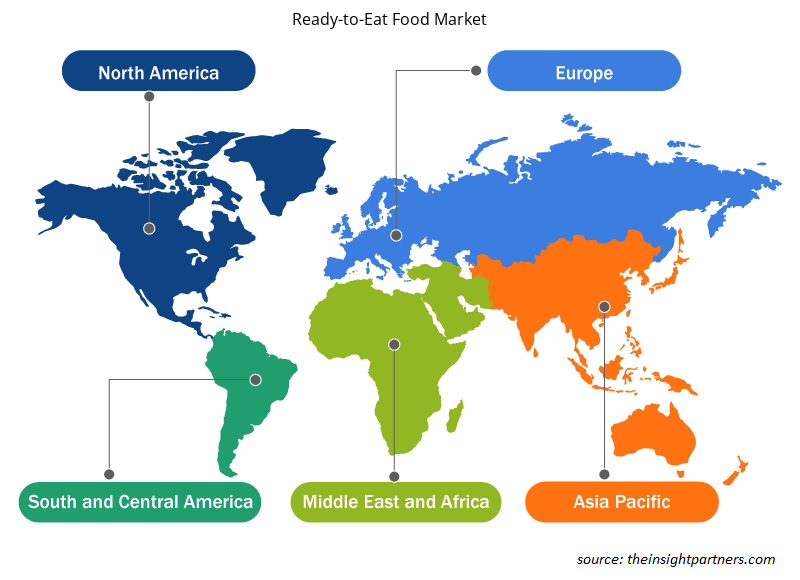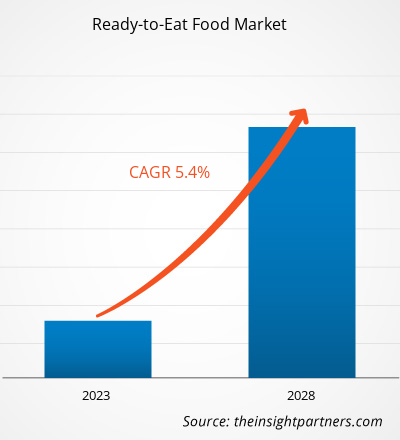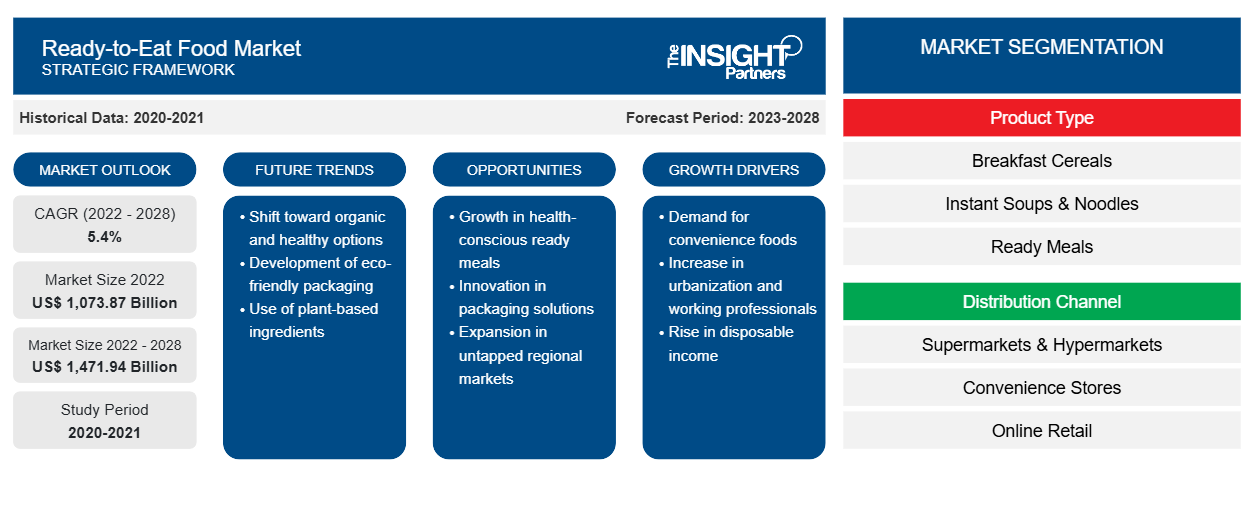[Forschungsbericht] Der Markt für verzehrfertige Lebensmittel soll von 1.073,87 Milliarden US-Dollar im Jahr 2022 auf 1.471,94 Milliarden US-Dollar im Jahr 2028 anwachsen. Von 2022 bis 2028 wird mit einer durchschnittlichen jährlichen Wachstumsrate von 5,4 % gerechnet.
Verzehrfertige Lebensmittel sind verschiedene verarbeitete und verpackte Lebensmittel, die ohne weitere Zubereitung verzehrt werden können. Die Zutaten werden gewaschen, gekocht, verarbeitet und zum direkten Verzehr in Behälter verpackt. Einige gängige Arten von verzehrfertigen Lebensmitteln sind Instantsuppen, Backwaren, Desserts und Fertiggerichte. Diese Produkte sind mit verschiedenen Extrakten, Säuren, Aromen, Süßstoffen , Antioxidantien und Konservierungsstoffen angereichert. Sie bieten dem Verbraucher enormen Komfort, tragen zur Verkürzung der Zubereitungszeit bei und sorgen für eine längere Haltbarkeit der Produkte, Kosteneffizienz und minimalen Verderb.
Der asiatisch-pazifische Raum hatte im Jahr 2020 den größten Anteil am Markt für verzehrfertige Lebensmittel , während andere Entwicklungsregionen wie der Nahe Osten und Afrika im Prognosezeitraum voraussichtlich deutlich wachsen werden. Wichtige Akteure auf dem Markt für verzehrfertige Lebensmittel weiten ihre Aktivitäten im asiatisch-pazifischen Raum aus, da die Erwerbsbevölkerung zunimmt und die Menschen in Entwicklungsländern einen hektischen Lebensstil pflegen. Immer mehr Menschen entscheiden sich dafür, unterwegs oder außer Haus zu essen.
Darüber hinaus haben zahlreiche Studien ergeben, dass transnationale Lebensmittel- und Getränkekonzerne (TFBCs) die Lebensmittelsysteme und den allgemeinen Konsum auf eine Weise geprägt haben, die die Verfügbarkeit, Attraktivität, den Preis und letztlich den Konsum verarbeiteter Lebensmittel verändert. Das Wachstum des Marktes für verzehrfertige Lebensmittel ist vor allem in Ländern mit mittlerem Einkommen zu beobachten.TFBCs) have shaped food systems and general consumption in ways, which change the availability, desirability, price, and ultimately consumption of processed foods. The growth of ready-to-eat food market has been prominently observed in middle-income countries.
Passen Sie diesen Bericht Ihren Anforderungen an
Sie erhalten kostenlose Anpassungen an jedem Bericht, einschließlich Teilen dieses Berichts oder einer Analyse auf Länderebene, eines Excel-Datenpakets sowie tolle Angebote und Rabatte für Start-ups und Universitäten.
-
Holen Sie sich die wichtigsten Markttrends aus diesem Bericht.Dieses KOSTENLOSE Beispiel umfasst eine Datenanalyse von Markttrends bis hin zu Schätzungen und Prognosen.
Auswirkungen der COVID-19-Pandemie auf den Markt für verzehrfertige Lebensmittel
Die COVID-19-Pandemie brachte Anfang 2020 beispiellose Herausforderungen für viele Branchen mit sich. Lockdowns, Grenzbeschränkungen, Reiseverbote, Produktionsunterbrechungen und andere Sicherheitsmaßnahmen, die von Regierungen gemäß den Richtlinien der WHO und der nationalen Gesundheitsministerien eingeführt wurden, behinderten die Produktionsabläufe. Andererseits wirkte sich der COVID-19-Ausbruch positiv auf den Markt für verzehrfertige Lebensmittel aus, da Verbraucher und Einzelhändler Fertiggerichte mit längerer Haltbarkeit auf Vorrat kauften. Auch Verbraucher, die nach gesünderen verpackten Lebensmitteln und Getränken zur Stärkung ihrer Immunität suchten, waren durch die Auswirkungen von COVID-19 alarmiert. Dann konzentrierten sich die Hersteller von verzehrfertigen Produkten auf gesunde und nahrhafte Produkte mit Anreicherung von Proteinen und anderen Nährwerten, was die Nachfrage nach verzehrfertigen Lebensmitteln während der Pandemie ankurbelte.Lockdowns, border restrictions, travel bans, manufacturing discontinuation, and other safety measures rolled out by governments as per the guidelines of the WHO, and national health ministries hampered the manufacturing operations. On the other hand, the COVID-19 outbreak positively impacted the ready-to-eat food market as consumers and retailers were stockpiling convenience food products with longer shelves. Also, consumers looking for healthier packaged food and beverage products to boost immunity were alarmed by the COVID-19 impact. Then, manufacturers of RTE products focused on healthy and nutritious products with enrichment of proteins and other nutritional values, which stimulated the demand for ready-to-eat food products during the pandemic.
Markteinblicke
Starke Vorliebe für Convenience Food unter Millennials treibt Marktwachstum an
Der Konsum hochwertiger Fertiggerichte nimmt zu und ist derzeit einer der größten Trends in der Lebensmittelindustrie. Mit Fertiggerichten wie RTE-Produkten sparen Verbraucher Zeit und Aufwand bei der Zubereitung und dem Kochen, dem Verzehr und den Aktivitäten nach dem Essen. Als Wachstumstreiber für dieses Lebensmittelsegment gelten zahlreiche gesellschaftliche Veränderungen, insbesondere die zunehmende Zahl kleinerer Haushalte und die wachsende Zahl der Millennials weltweit. Aufgrund ihres hektischen Arbeitsalltags möchten Millennials ihre Zeit lieber effizient nutzen, als sie mit langweiligen Aufgaben zu vergeuden. Sie geben ihr Geld eher für Convenience-Produkte aus. Daher bevorzugen sie zunehmend RTE-Produkte wie Backwaren, Snacks und Milchprodukte, was den Markt für verzehrfertige Lebensmittel weiter ankurbelt.millennials, they prefer to be efficient with their time rather than wasting it on tedious tasks. They are more likely to spend their money on convenience. Thus, they increasingly prefer RTE products, such as baked products, snacks, and dairy products, further driving the ready-to-eat food market.
Einblicke in Produkttypen
Basierend auf dem Produkttyp ist der Markt für verzehrfertige Lebensmittel in Frühstückszerealien, Instantsuppen und -nudeln, Fertiggerichte, Snacks, Backwaren und Süßwaren und Sonstiges unterteilt. Das Segment der sonstigen verzehrfertigen Lebensmittel wird im Prognosezeitraum voraussichtlich den größten Anteil verzeichnen. Weitere Typen sind Milchprodukte, Desserts, Brotaufstriche, Saucen und Dips. Verzehrfertige Milchprodukte sind Eiscreme, Joghurt, abgepackte aromatisierte Milch und Käse. Gesundheitsbewusste Verbraucher konsumieren hauptsächlich Milchprodukte, da herkömmliche Milchprodukte die Knochen- und Darmgesundheit verbessern und das Risiko von Herz-Kreislauf-Erkrankungen (CVDs) und Typ-2-Diabetes verringern. Die Beliebtheit von verarbeiteten und abgepackten Saucen und Dips wuchs, als die Menschen von traditionellen Lebensweisen abwichen und einen modernen Lebensstil annahmen, was das Wachstum des Marktes für verzehrfertige Lebensmittel ankurbelte.CVDs) and type 2 diabetes. The popularity of processed and packaged sauces and dips grew as people switched from traditional ways of living and adopted a modern lifestyle, fueling the growth of ready-to-eat food market.
Regionale Einblicke in den Markt für verzehrfertige Lebensmittel
Die regionalen Trends und Faktoren, die den Markt für verzehrfertige Lebensmittel während des Prognosezeitraums beeinflussen, wurden von den Analysten von Insight Partners ausführlich erläutert. In diesem Abschnitt werden auch Marktsegmente und Geografien für verzehrfertige Lebensmittel in Nordamerika, Europa, im asiatisch-pazifischen Raum, im Nahen Osten und Afrika sowie in Süd- und Mittelamerika erörtert.

- Erhalten Sie regionale Daten zum Markt für verzehrfertige Lebensmittel
Umfang des Marktberichts über verzehrfertige Lebensmittel
| Berichtsattribut | Details |
|---|---|
| Marktgröße im Jahr 2022 | 1.073,87 Milliarden US-Dollar |
| Marktgröße bis 2028 | 1.471,94 Milliarden US-Dollar |
| Globale CAGR (2022 - 2028) | 5,4 % |
| Historische Daten | 2020-2021 |
| Prognosezeitraum | 2023–2028 |
| Abgedeckte Segmente |
Nach Produkttyp
|
| Abgedeckte Regionen und Länder |
Nordamerika
|
| Marktführer und wichtige Unternehmensprofile |
|
Marktdichte von Fertiggerichten: Auswirkungen auf die Geschäftsdynamik
Der Markt für verzehrfertige Lebensmittel wächst rasant. Die Nachfrage der Endverbraucher steigt aufgrund von Faktoren wie sich entwickelnden Verbraucherpräferenzen, technologischen Fortschritten und einem größeren Bewusstsein für die Vorteile des Produkts. Mit der steigenden Nachfrage erweitern Unternehmen ihr Angebot, entwickeln Innovationen, um die Bedürfnisse der Verbraucher zu erfüllen, und nutzen neue Trends, was das Marktwachstum weiter ankurbelt.
Die Marktteilnehmerdichte bezieht sich auf die Verteilung der Firmen oder Unternehmen, die in einem bestimmten Markt oder einer bestimmten Branche tätig sind. Sie gibt an, wie viele Wettbewerber (Marktteilnehmer) in einem bestimmten Marktraum im Verhältnis zu seiner Größe oder seinem gesamten Marktwert präsent sind.
Die wichtigsten Unternehmen auf dem Markt für verzehrfertige Lebensmittel sind:
- Nestlé SA
- Conagra Brands Inc.
- Die Kraft Heinz Company
- General Mills Inc.
- CAMPBELL SOUP COMPANY
Haftungsausschluss : Die oben aufgeführten Unternehmen sind nicht in einer bestimmten Reihenfolge aufgeführt.

- Überblick über die wichtigsten Akteure auf dem Markt für verzehrfertige Lebensmittel
Einblicke in Vertriebskanäle
Basierend auf den Vertriebskanälen wurde der Markt für verzehrfertige Lebensmittel in Supermärkte und Hypermärkte, Convenience Stores, Online-Einzelhandel und andere unterteilt. Der Online-Einzelhandel wird im Prognosezeitraum voraussichtlich die höchste durchschnittliche jährliche Wachstumsrate im Markt für verzehrfertige Lebensmittel verzeichnen. Der Online-Einzelhandel bietet den Benutzern ein bequemes Einkaufserlebnis, gefolgt von einer vereinfachten Produktlieferung. Online-Einzelhandelsgeschäfte bieten eine breite Produktpalette zu hohen Rabatten; außerdem können Verbraucher gewünschte Produkte bequem aus der Ferne kaufen.
Die wichtigsten Akteure auf dem Markt für verzehrfertige Lebensmittel sind Nestlé SA; Conagra Brands Inc.; The Kraft Heinz Company; General Mills Inc.; CAMPBELL SOUP COMPANY; MTR Foods Pvt Ltd.; Hormel Foods Corporation; Tyson Foods, Inc.; JBS SA; und The Kellogg Company. Diese Akteure entwickeln Produkte mit reduzierten Gesundheitsrisiken, um aufkommende Verbrauchertrends zu erfüllen und gesetzliche Rahmenbedingungen einzuhalten. Sie sind an Fusionen und Übernahmen, Geschäftserweiterungen und Partnerschaften beteiligt, um ihren Marktanteil zu vergrößern.
Bericht-Spotlights
- Fortschrittliche Branchentrends im Markt für verzehrfertige Lebensmittel helfen den Akteuren bei der Entwicklung wirksamer langfristiger Strategien
- Einführung von Geschäftswachstumsstrategien zur Sicherung des Wachstums in entwickelten und sich entwickelnden Märkten
- Quantitative Analyse des Marktes für verzehrfertige Lebensmittel von 2019 bis 2028
- Schätzung der weltweiten Nachfrage nach verzehrfertigen Lebensmitteln
- Porters Fünf-Kräfte-Analyse zur Veranschaulichung der Wirksamkeit der in der Branche tätigen Käufer und Lieferanten
- Aktuelle Entwicklungen zum Verständnis des Wettbewerbsmarktszenarios
- Markttrends und -aussichten sowie Faktoren, die das Wachstum des Marktes für verzehrfertige Lebensmittel bestimmen
- Unterstützung im Entscheidungsprozess durch Aufzeigen von Marktstrategien, die das kommerzielle Interesse untermauern und zum Marktwachstum führen
- Größe des Marktes für verzehrfertige Lebensmittel an verschiedenen Knotenpunkten
- Detaillierte Übersicht und Segmentierung des Marktes und der RTE-Produktbranchendynamik
- Ausmaß des Wachstums in verschiedenen Regionen mit vielversprechenden Wachstumschancen
- Historische Analyse (2 Jahre), Basisjahr, Prognose (7 Jahre) mit CAGR
- PEST- und SWOT-Analyse
- Marktgröße Wert/Volumen – Global, Regional, Land
- Branchen- und Wettbewerbslandschaft
- Excel-Datensatz
Aktuelle Berichte
Verwandte Berichte
Erfahrungsberichte
Grund zum Kauf
- Fundierte Entscheidungsfindung
- Marktdynamik verstehen
- Wettbewerbsanalyse
- Kundeneinblicke
- Marktprognosen
- Risikominimierung
- Strategische Planung
- Investitionsbegründung
- Identifizierung neuer Märkte
- Verbesserung von Marketingstrategien
- Steigerung der Betriebseffizienz
- Anpassung an regulatorische Trends























 Kostenlose Probe anfordern für - Markt für verzehrfertige Lebensmittel
Kostenlose Probe anfordern für - Markt für verzehrfertige Lebensmittel